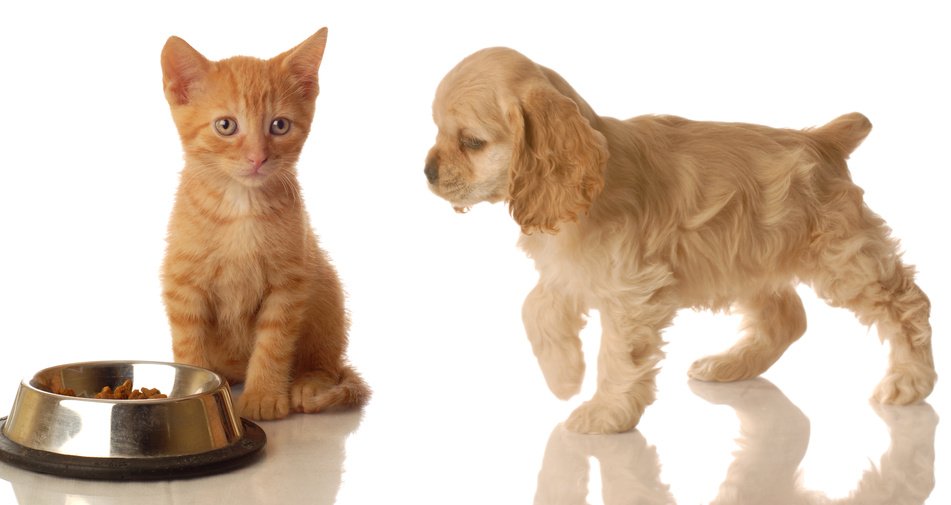Nutrition for your new kitten or puppy begins before they’re born. It starts in the womb, where the right diet for the mother is critical. Once your pup or kitten is born, it’s okay to start feeding a raw diet after they’re weaned at about 5wks of age.
If you think about a feral dog or cat mom, they regurgitate food for their babies once they’re weaned. The feral versions of our pets don’t bring home special prey that’s formulated for their young. It’s the same food the adults eat. The only nutritional consideration beyond a complete meal, like Fetching Foods, is the amount fed.
Young animals need to eat more. At least 10% more (sometimes twice the amount) than an adult at the same weight. High quality proteins are excellent for your furbaby’s health. Pups and kittens need to be fed more often, 3-5 times a day until about 20wks old. More frequent feedings are needed because their stomachs are small but still need to accommodate more food for a rapidly growing body.
Feeding can be as much of a science as an art. The feeding table in our FAQ is a good starting point for most kitties. Don’t take it as an authoritative guideline. You’ll need to adapt the amounts listed for your specific situation.
The more you expose your kitten or pup to different proteins, the less finicky companion you’ll have later in life. Introduce them to lots of proteins and textures. Don’t feed them the same food day after day unless you want a picky eater.
A large study from the University of Helsinki shows strong evidence puppies develop allergies and skin issues if they’re fed an all kibble diet. There’s a strong likelihood that a raw diet early in life can prevent adult health issues extends to kittens as well. It makes sense that as fur babies develop, having a raw, natural diet will shape their health as an adult [REF].
You may be aware we added two new kittens to our house recently, Jules and Royal. We fed, and still do most of the time, three times a day: 7am, noon-ish, and 6:30p. They’re 16wks old right now.
We feed about 50% more than an adult cat their size at 7a and 6:30p. They usually eat it all, but not always. The noon feeding is more of a snack than a meal. When they’re in a growth spurt they really eat like savages, and other times there’s a temporary sag in appetite. During the first year, sometimes to 18mos, you may need to feed by appetite, since they will grow and pause. Feeding more during the growth spurt then cutting back some when the spurt’s over. Keep in mind that as they mature out of the kitten phase, overfeeding can lead to lowered appetite and becoming picky.
Watch their body composition to accurately judge if you’re feeding too much or too little. Seeing/Feeling the ribs and a slender waist, and able to feel the hip bones means you’re under feeding. Bulging waist could mean overfeeding.
The benefit of owning a pet food company is the kittens (and our dogs) get lots of variety. We’ve found our kittens prefer bird proteins but also like lamb, are okay with beef, and avoid the Just Cat Venison. They, however, love the venison bites, all of the bites actually, all of the jerky treats, and all of the broths. Keeping a variety is important not to only avoid picky cats but nutritionally. No one protein is perfect, each having better values for some nutrients and lower values for others. So rotating several in their diet creates a higher average of all the nutrients. Rotating proteins also helps to avoid sensitivities that can develop over long periods of feeding the same protein.
A general rule is that it’s difficult to over feed a kitten but easy to underfeed. The bottomline with the amount is err on the side of feeding more, not less when they’re kittens. For adults it’s usually better to feed less than more.
When you get a kitten or a puppy, after they’re weaned, it’s okay to have raw food ready for them on day one. Feed them 3-5 times a day so they can get the calories required for proper growth. And finally introduce them to a variety of proteins and textures so you have a cat or dog that is a flexible eater and has robust nutrition.

In recent years, pet owners have become increasingly concerned about the quality and nutritional value of the food they feed their furry companions. One trend that has been gaining popularity is the use of hydrolyzed ...
Introduction As pet owners, we are constantly seeking ways to improve the health and well-being of our beloved furry companions. One aspect that has gained significant attention in recent years is the use of herbal ...
As we move through this holiday season and towards the new year, we’ve been stuffing our faces as we prepare to stuff our stockings! You might already be at the point where you are loosening ...